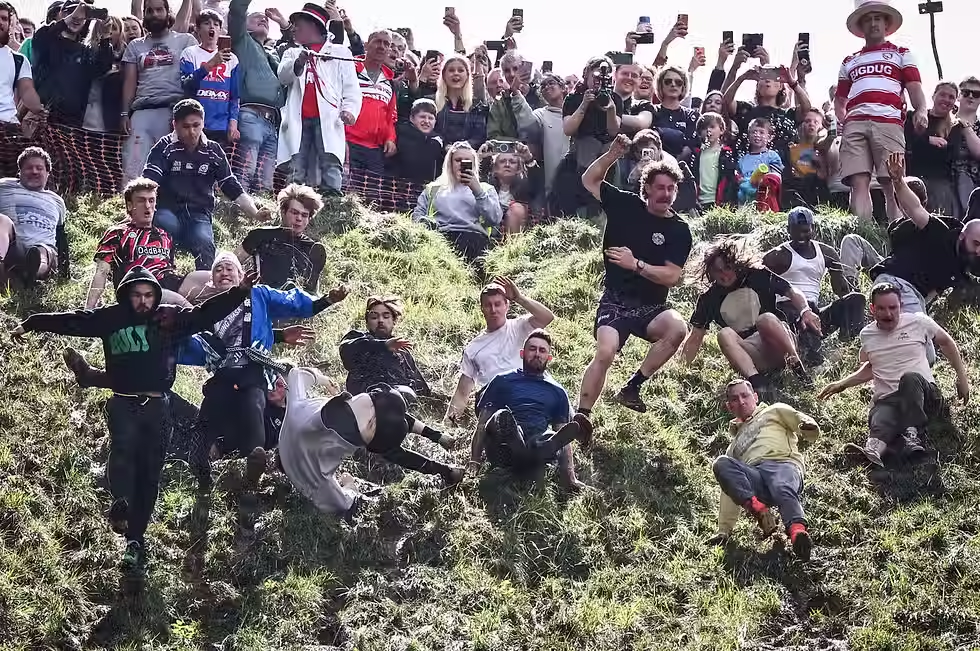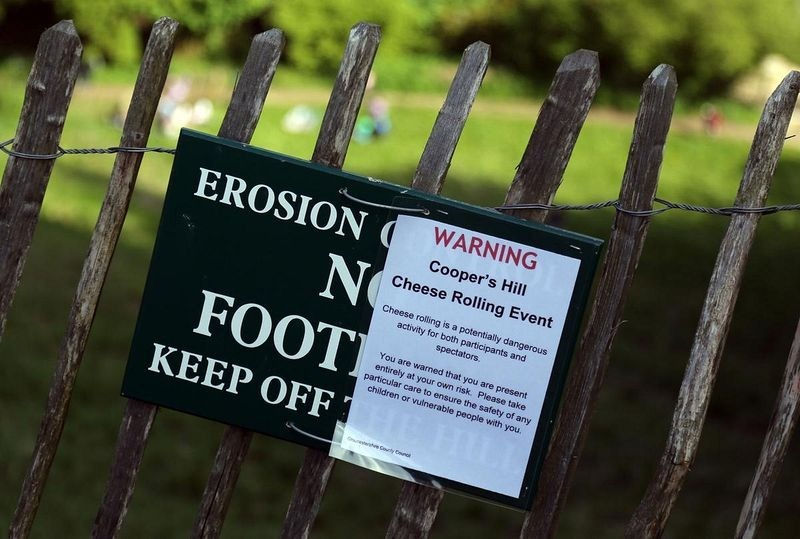Chasing Cheese: The Global Tradition of Cheese-Rolling
- Diego Tobias

- Apr 29
- 6 min read
Updated: May 13

The wild spectacle of cheese-rolling is centuries old. Villagers in Brockworth, Gloucestershire have gathered every Spring Bank Holiday to send a round of Double Gloucester hurtling down Cooper’s Hill, sparking a madcap chase. While the first recorded mention of this event is a letter to the Gloucester town crier in 1826 – even then noting it as an “old tradition” at least six centuries old – many scholars link it to much earlier pagan spring rituals. Some historians suggest it evolved from ancient rites marking the return of spring (even involving rolling burning brushwood down the hill) or a local plea for grazing rights. In 19th-century accounts it was already considered “a heathen festival to celebrate the return of spring”. Whatever its true origins, the spectacle – chasing a cheese wheel down a steep grassy slope – has persisted for generations, passed down as a quirky local custom.
The Cooper’s Hill Cheese-Rolling Spectacle
The centerpiece of the tradition is Cooper’s Hill itself – a 200-yard (180 m) near-vertical slope where the race unfolds. Competitors gather at the top and, at a signal, dash down after an 8–9 lb round of Double Gloucester cheese. From the summit the hill looks impossibly steep and concave – so much so that the actual running surface is barely visible from the start. Runners throw themselves forward as the cheese thunders ahead, often reaching breakneck speeds. The winner is simply the first person to cross the line at the bottom. By local decree the prize is the cheese wheel itself – earning the aptly named Cooper’s Hill race its reputation as “the world’s wackiest race.” As The Guardian noted, this “world-famous event” now draws daredevils and spectators from across the globe.. In recent years TV crews and news outlets flock to Brockworth – in 2023, for example, multiple European television crews and thousands of onlookers packed the course.
The Cooper’s Hill contest has evolved somewhat. For safety, organizers briefly used a lightweight foam “cheese” in 2013, but reverted to a real Double Gloucester wheel in 2014. (Longtime local cheesemakers still donate real cheese for the chase and for charity.) Today there are separate races for men and women, often several heats in succession. Police routinely advise wearers of helmets and sturdy shoes. Still, in Cooper’s Hill fashion the rules remain minimal: chase the cheese, make it down first. The pure mayhem of the run, combined with the raw rural setting and scant official organization, is what makes Cooper’s Hill unique. As a senior Gloucestershire police officer put it this May, the race is a “unique tradition” and nobody has “any desire to stop it” – yet he reminds all participants to “consider the risk” involved.

Risks, Injuries and Controversy
Every year’s race brings injuries – from bruises and twisted ankles to the occasional broken bone. Over the decades dozens of competitors have banged themselves up. For example, in 1993 sixteen people were hurt (four of them seriously) when the greasy slope proved too much even for veterans As police and medics warned in recent years, the hill’s 1:2 gradient makes falls almost inevitable. In 2023, for instance, the women’s race winner lost consciousness at the finish line and later woke up in a medical tent, only then learning she had won. Last year’s event strained emergency services so much that a safety advisory group declared the unofficial race “unsafe,” reporting ambulances struggled to reach injured runners on site. One Gloucestershire Police commander bluntly warned that if “a major incident were to occur,” it would likely cause “multiple casualties”. Local resilience officials have even warned of “mass casualties” if a crush happened at the start.
Despite the obvious danger, official authority is in a bind. Cooper’s Hill is privately owned common land with no formal organizer. The police openly admit they “are never going to stop the event” – it is “a fantastic part of our heritage,” they say – but they continue to urge caution and advise spectators to “go at your own risk”. As a result of safety concerns, the once-official event was cancelled in 2010 after a record crowd of about 15,000 spectators showed up in 2009. Organizers’ attempts to tamer the event – for instance, by proposing paid, ticketed admission in 2011 – were met with fierce local resistance, so since then the chase has continued in its traditional unofficial, unticketed form with police simply monitoring rather than managing. The race was even called off entirely in 2020 and 2021 due to COVID-19, but its comeback in 2022 (and again in 2024) only reinforced its reputation: thrill-seekers now travel from all over the world to run or watch.

Media Spotlight and Cultural Impact
What started as a village wake has become global folklore. Cooper’s Hill cheese-rolling is now regularly featured on news shows, YouTube and travel documentaries, often with dramatic slo-motion replays of racers somersaulting down the slope. For example, the popular YouTube channel Slo Mo Guys filmed the chase in 2024 at 800 frames per second, capturing every tumble and flying bit of grass. British newspapers and foreign media treat it as a must-see oddity: The Independent reported that TV crews from across Europe descend on the hill each May, and noted how even foreign visitors (like an Australian in Speedos) compete for the cheese. Every year Guinness World Records codifies “the cheese-rolling world’s most champion,” while local TV reporters interview winners with broken bones like celebrities. The event draws tens of thousands of spectators along the course and on the surrounding roads, which are often closed for miles around Cooper’s Hill on the holiday. In short, Cooper’s Hill has become not just a local rite but a symbol of eccentric British folklore, and a draw for adventure tourists worldwide.
Cheese-Rolling Around the World
While Cooper’s Hill is the original cheese-race, the idea has inspired many other festivals globally – usually much gentler and better organized than the Gloucestershire chase. In Italy, for example, the village of Panicale in Umbria revives an ancient spring custom called Ruzzolone. On Easter Monday locals attach leather straps to four-kilo wheels of Pecorino and launch them down narrow cobbled streets, aiming to roll the cheese around the medieval town walls in the fewest “throws”. (This game, dating back to Etruscan times, is part bocce and part yo-yo; spotters mark where the cheese stops after each roll) Although it involves chasing cheese on grass instead of bounding after it on concrete, Ruzzolone shares the same festive spirit. As one travel writer notes, Panicale’s Ruzzolone is “said to be over 3,000 years old, having originated during Etruscan times”, showing the deep cultural roots of cheese-chasing traditions.
In Canada, the custom has been turned into a large, family-friendly festival. Every summer Whistler, British Columbia hosts the Great Canadian Cheese Rolling Festival (sponsored by the Dairy Farmers of Canada). About 10,000 fans gather at the ski resort, where participants chase an 11-pound wheel down a gentle grassy ski slope in pursuit of prize ski passes. Women’s and men’s heats culminate in a finals where the first racer over the line wins two ski season passes and the very wheel of cheese. The event also includes live music, cheese markets, costume contests and kids’ races uphill, making it a full-day celebration of dairy culture. Organizers emphasize safety here: the slope is much less steep than Cooper’s Hill and obstacles are padded, with helmets required.
Down under, Australia has its own version. In the Snowy Mountains of New South Wales, the village of Thredbo holds an annual “Australian Cheese Rolling Festival” each autumn (tied to a local cheese-and-wine fair). Competitors hurtle down a ski run after a 5-kilogram wheel of local high-country cheese under full-face helmets. Though still risky, the crowds are smaller (hundreds rather than thousands), and the atmosphere is cheerfully communal. As one Australian participant laughed after her chase, the Thredbo event is a toned-down homage to Brockworth’s, even serving Coolamon cheese instead of Gloucester.
Other examples abound. In New Zealand, rural shows sometimes feature fun races where local cheddar or gouda wheels are rolled downhill at agricultural fairs. In the United States, the tradition has mostly inspired one-off festival races. For instance, Vermont cheesemakers and enthusiasts stage an annual “Double Gloucester cheese rolling” in Chester, VT, where participants dash after Gloucester wheels down a grassy knoll, “bringing a taste of English eccentricity to the U.S.”. Similarly, novelty cheese-chasing races have popped up at Wisconsin and Oregon cheese festivals, often as light-hearted charity events. (There is even a team-based Stilton cheese-rolling in Cambridgeshire, England, and small contests at British food shows, though none match Cooper’s Hill in scale or savagery.)
Each of these international events retains a sense of pageantry and local flavor – whether it’s Alpine beats in France’s “La Ramelette” hill-runs, bocce-style tactics in Italy, or ski-lift giveaways in Canada – but they all share the same thrill of chasing cheese down a hill. The Gloucestershire original remains the fiercest and most notorious, but its global imitators underscore a universal appeal: cheese rolling is simple, visual fun that transforms a humble dairy product into a symbol of community spirit and springtime mischief. For competitors and spectators alike, the spectacle offers a dose of adrenaline and laughter. As one local commenter summed up, rolling cheese down a hill “is as English as it gets,” blending history, hazard and hedonism into a beloved annual spectacle.










Comments